Molecular Dynamic Simulation and Experiment Validation on the Diffusion Behavior of Diffusion Welded Fe-Ti by Hot Isostatic Pressing Process
Abstract
1. Introduction
2. Materials and Methods
2.1. Simulation Method
2.2. Diffusion Welding Experiment
3. Results and Discussion
3.1. MD Simulation Results
3.2. Diffusion Experiment Results
3.3. Analysis on Diffusion Coefficient
4. Conclusions
- (1)
- MD simulations of Fe-Ti joints at 1123 K and 1223 K show that the diffusion layer thickness is relatively larger at 1223 K compared to 1123 K. The diffusion layer becomes thicker with increasing diffusion time. The diffusion coefficients obtained from the MD simulations are at the level of 10−14 m2/s.
- (2)
- Comparing the simulation results between single crystals and polycrystals, it is observed that the diffusion layer is thinner in a single crystal than in a polycrystal at the same temperature. This difference may be due to the presence of grain boundaries in polycrystals, which increase atomic disorder and facilitate diffusion.
- (3)
- The RDF curves of Fe-Fe and Ti-Ti exhibit similar patterns at different times, showing a single main peak indicating the highest number density of atoms within that radius range and relatively strong bonding between the central atoms and their nearest neighbors. Increasing temperature leads to an increase in the peak value of Fe-Ti.
- (4)
- The trend of the diffusion coefficient changing with temperature in the simulation results agrees well with the experimental findings. The disparity in the diffusion coefficient values between simulation and experiment may be attributed to the presence of gaps, or noncontinuous interfaces, between Fe and Ti in the experiments.
Author Contributions
Funding
Institutional Review Board Statement
Informed Consent Statement
Data Availability Statement
Conflicts of Interest
References
- Attar, H.; Ehtemam-Haghighi, S.; Kent, D.; Dargusch, M.S. Recent Developments and Opportunities in Additive Manufacturing of Titanium-Based Matrix Composites: A Review. Int. J. Mach. Tools Manuf. 2018, 133, 85–102. [Google Scholar] [CrossRef]
- Kang, L.M.; Yang, C. A Review on High-Strength Titanium Alloys: Microstructure, Strengthening, and Properties. Adv. Eng. Mater. 2019, 21, 1801359. [Google Scholar] [CrossRef]
- Geetha, M.; Singh, A.K.; Asokamani, R.; Gogia, A.K. Ti Based Biomaterials, the Ultimate Choice for Orthopaedic Implants—A Review. Prog. Mater. Sci. 2009, 54, 397–425. [Google Scholar] [CrossRef]
- Philip, J.T.; Mathew, J.; Kuriachen, B. Tribology of Ti6Al4V: A Review. Friction 2019, 7, 497–536. [Google Scholar] [CrossRef]
- Li, B.; Chen, Z.; He, W.; Zhou, T.; Wang, Y.; Peng, L.; Li, J.; Liu, Q. Effect of Titanium Grain Orientation on the Growth of Compounds at Diffusion Bonded Titanium/Steel Interfaces. Mater. Charact. 2019, 148, 243–251. [Google Scholar] [CrossRef]
- Prasanthi, T.N.; Sudha, C.; Saroja, S. An Overview on the Microstructure and Properties of Fe/Ti Based Dissimilar Joints. Mater. Sci. Technol. 2023, 1–21. [Google Scholar] [CrossRef]
- Lin, J.; Nambu, S.; Koseki, T. Interfacial Phenomena during Ultrasonic Welding of Ultra-Low-Carbon Steel and Pure Ti. Scr. Mater. 2020, 178, 218–222. [Google Scholar] [CrossRef]
- Zhang, Y.; Sun, D.; Gu, X.; Li, H. Strength Improvement and Interface Characteristic of Direct Laser Welded Ti Alloy/Stainless Steel Joint. Mater. Lett. 2018, 231, 31–34. [Google Scholar] [CrossRef]
- Cheepu, M.; Susila, P. Interface Microstructure Characteristics of Friction-Welded Joint of Titanium to Stainless Steel with Interlayer. Trans. Indian Inst. Met. 2020, 73, 1497–1501. [Google Scholar] [CrossRef]
- Zhang, Y.; Sun, D.Q.; Gu, X.Y.; Duan, Z.Z.; Li, H.M. Nd:YAG Pulsed Laser Welding of TC4 Ti Alloy to 301L Stainless Steel Using Ta/V/Fe Composite Interlayer. Mater. Lett. 2018, 212, 54–57. [Google Scholar] [CrossRef]
- Meshram, S.D.; Mohandas, T.; Reddy, G.M. Friction Welding of Dissimilar Pure Metals. J. Mater. Process. Technol. 2007, 184, 330–337. [Google Scholar] [CrossRef]
- Gotawala, N. Thermodynamics-Based Analysis of Formation and Growth of FeTi and b -Ti during Friction Stir Welding of SS304 and Pure Titanium. J. Mater. Sci. 2021, 56, 19180–19198. [Google Scholar] [CrossRef]
- Rodmacq, B.; Hillairet, J.; Laugier, J.; Chamberod, A. Structural and Transport Properties of Fe/Ti Multilayers. J. Phys. Condens. Matter 1990, 2, 95–108. [Google Scholar] [CrossRef]
- Cheng, Z.; Huang, J.; Ye, Z.; Yang, J.; Chen, S. Butt Brazing of Titanium Alloys/Stainless Steel Plates by MIG-TIG Double-Sided Arc Welding Process with Copper Filler Metal. J. Mater. Res. Technol. 2019, 8, 1566–1570. [Google Scholar] [CrossRef]
- Liu, K.; Li, Y.; Wang, J. Improving the Interfacial Microstructure Evolution of Ti/Stainless Steel GTA Welding Joint by Employing Cu Filler Metal. Mater. Manuf. Process. 2016, 31, 2165–2173. [Google Scholar] [CrossRef]
- Chu, Q.; Li, J.; Tong, X.; Xu, S.; Zhang, M.; Yan, C. Nanoindentation and Microstructure Analysis of Ti/Fe Dissimilar Joint. Mater. Lett. 2019, 238, 98–101. [Google Scholar] [CrossRef]
- Ramirez, J.E. Mechanical Behavior of Titanium-Clad Steel Welded Joints. Weld. J. 2014, 93, 369S–378S. [Google Scholar]
- Pugacheva, N.B.; Orishich, A.M.; Cherepanov, A.N.; Senaeva, E.I.; Trushina, E.B. Study of the Chemical Composition and Microstructure of AISI 321/Cu/Ta/Ti Welded Joint. Phys. Met. Metallogr. 2020, 121, 1112–1118. [Google Scholar] [CrossRef]
- Wu, T.; Yang, C. Influence of Pulse TIG Welding Thermal Cycling on the Microstructure and Mechanical Properties of Explosively Weld Titanium/Steel Joint. Vacuum 2022, 197, 110817. [Google Scholar] [CrossRef]
- Wu, T.; Yang, C. Interfacial Evolution and Mechanical Behavior of Explosively Welded Titanium/Steel Joint under Subsequent Heat Treatment Process. Int. J. Adv. Manuf. Technol. 2022, 121, 6303–6314. [Google Scholar] [CrossRef]
- Cui, Y.; Liu, D.; Zhang, Y.; Deng, G.; Fan, M.; Chen, D.; Sun, L.; Zhang, Z. The Microstructure and Mechanical Properties of TA1-Low Alloy Steel Composite Plate Manufactured by Explosive Welding. Metals 2020, 10, 663. [Google Scholar] [CrossRef]
- Balogh, J.; Hegedűs, L.G.; Kaptás, D.; Merkel, D.G.; Nakanishi, A.; Nagy, D.L. Evolution of the Fe-on-Ti and Ti-on-Fe Interfaces under Thermal Treatment. Thin Solid Films 2021, 721, 138551. [Google Scholar] [CrossRef]
- Prasanthi, T.N.; Sudha, C.; Saroja, S. Molecular Dynamics Simulation of Diffusion of Fe in HCP Ti Lattice. Trans. Indian Inst. Met. 2018, 71, 1951–1955. [Google Scholar] [CrossRef]
- Xiang, G.; Luo, X.; Cao, T.; Zhang, A.; Yu, H. Atomic Diffusion and Crystal Structure Evolution at the Fe-Ti Interface: Molecular Dynamics Simulations. Materials 2022, 15, 6302. [Google Scholar] [CrossRef] [PubMed]
- Thompson, A.P.; Aktulga, H.M.; Berger, R.; Bolintineanu, D.S.; Brown, W.M.; Crozier, P.S.; in ’t Veld, P.J.; Kohlmeyer, A.; Moore, S.G.; Nguyen, T.D.; et al. LAMMPS—A Flexible Simulation Tool for Particle-Based Materials Modeling at the Atomic, Meso, and Continuum Scales. Comput. Phys. Commun. 2022, 271, 108171. [Google Scholar] [CrossRef]
- Hirel, P. Atomsk: A Tool for Manipulating and Converting Atomic Data Files. Comput. Phys. Commun. 2015, 197, 212–219. [Google Scholar] [CrossRef]
- Baskes, M.I. Modified Embedded-Atom Potentials for Cubic Materials and Impurities. Phys. Rev. B 1992, 46, 2727–2742. [Google Scholar] [CrossRef]
- Sa, I.; Lee, B.J. Modified Embedded-Atom Method Interatomic Potentials for the Fe-Nb and Fe-Ti Binary Systems. Scr. Mater. 2008, 59, 595–598. [Google Scholar] [CrossRef]
- Qiu, C.; Adkins, N.J.E.; Attallah, M.M. Microstructure and Tensile Properties of Selectively Laser-Melted and of HIPed Laser-Melted Ti-6Al-4V. Mater. Sci. Eng. A 2013, 578, 230–239. [Google Scholar] [CrossRef]
- Helle, A.S.; Easterling, K.E.; Ashby, M.F. Hot-Isostatic Pressing Diagrams: New Developments. Acta Metall. 1985, 33, 2163–2174. [Google Scholar] [CrossRef]
- Stukowski, A. Visualization and Analysis of Atomistic Simulation Data with OVITO-the Open Visualization Tool. Model. Simul. Mater. Sci. Eng. 2010, 18, 015012. [Google Scholar] [CrossRef]
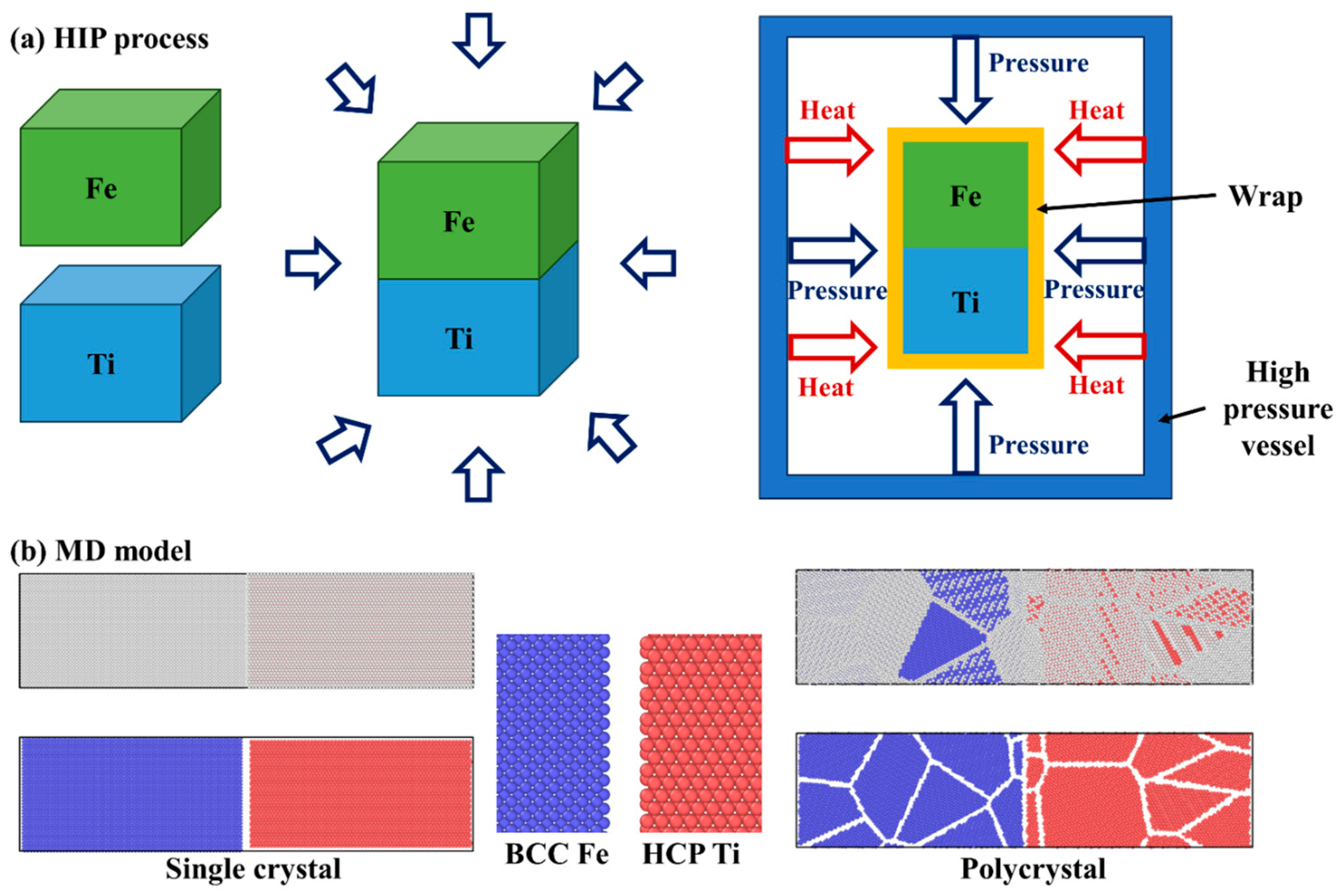

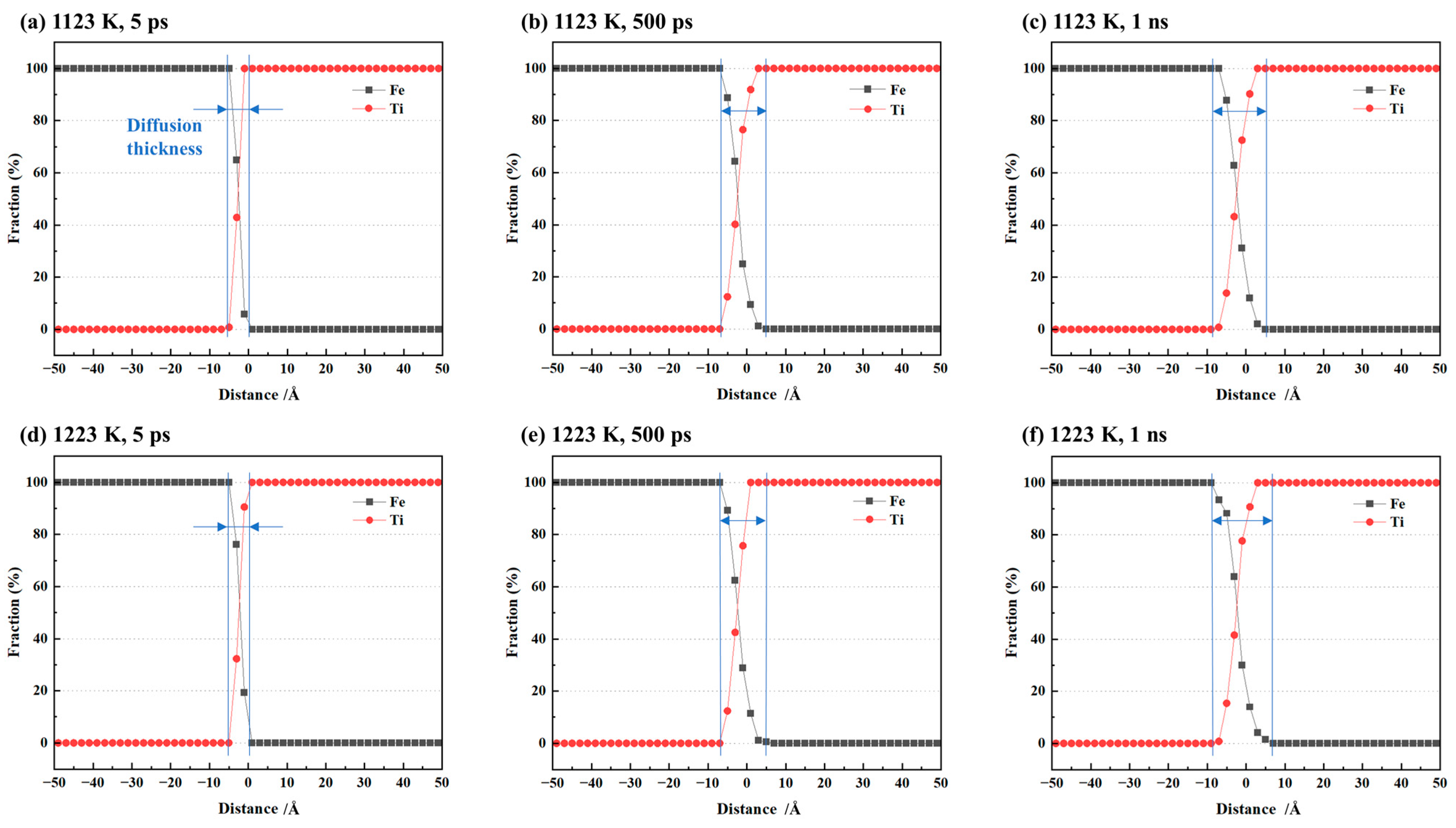

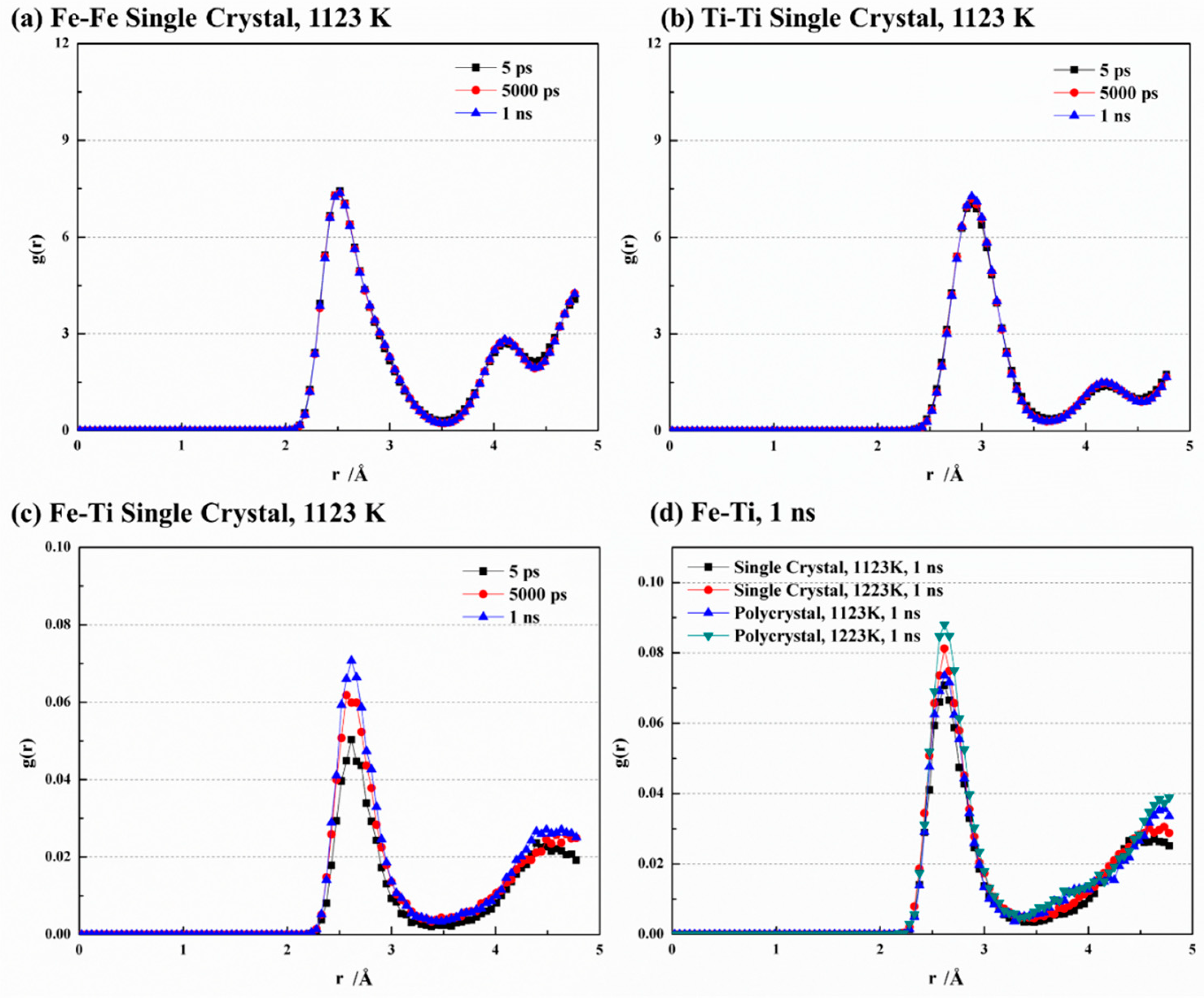



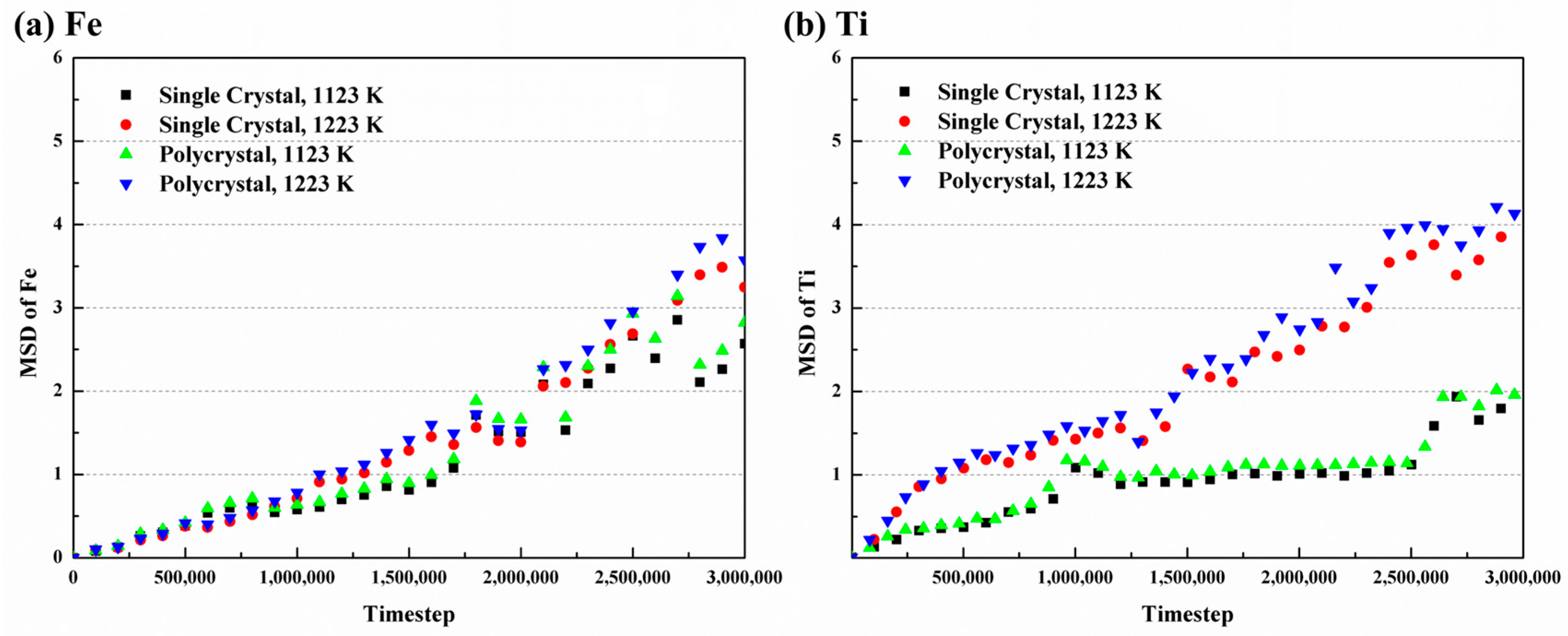
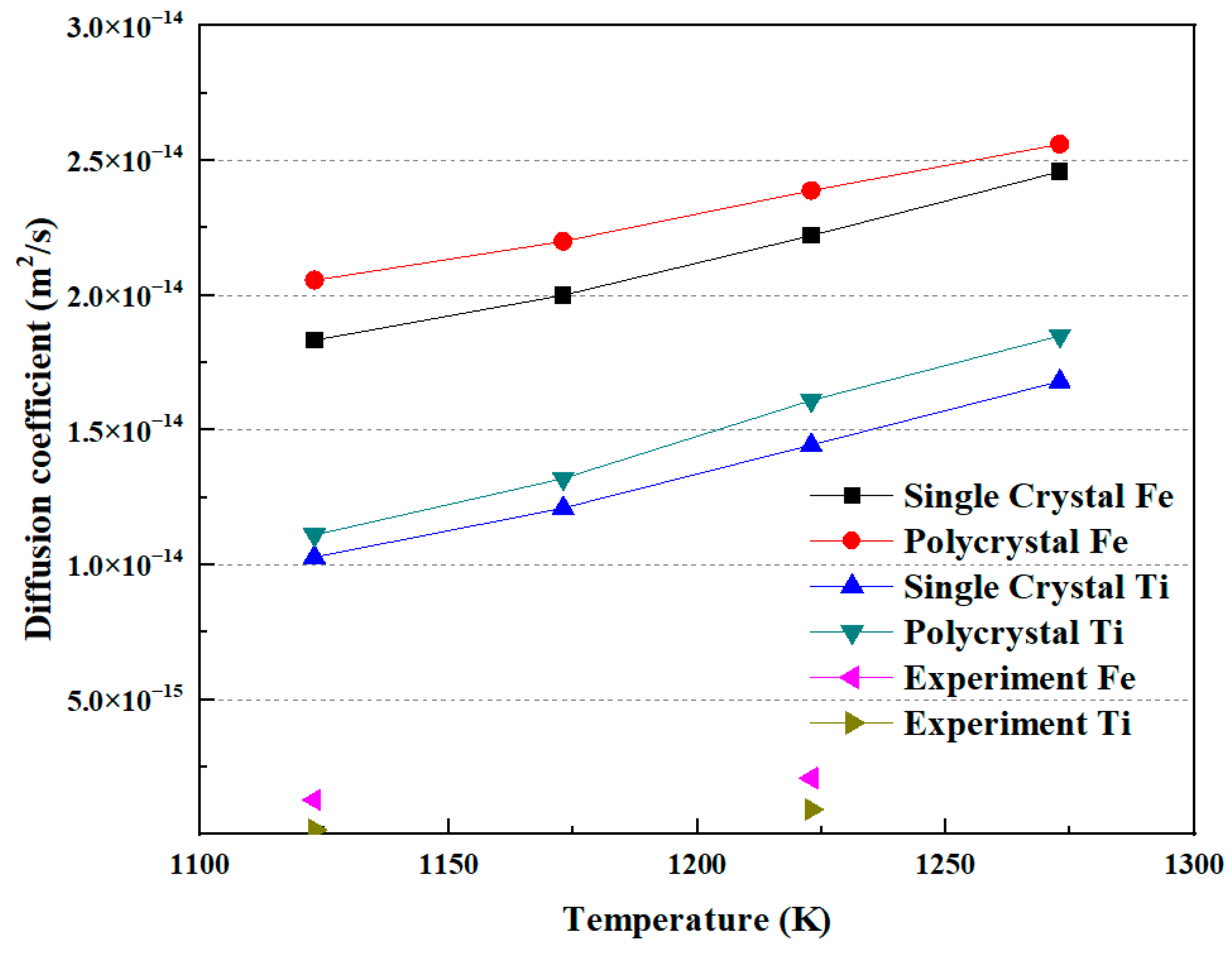
| Element | Cr | Ni | Mo | Mn | Si | C | Fe |
|---|---|---|---|---|---|---|---|
| Value | 16.8 | 10.9 | 2.3 | 2.0 | 1.10 | 0.03 | Balanced |
Disclaimer/Publisher’s Note: The statements, opinions and data contained in all publications are solely those of the individual author(s) and contributor(s) and not of MDPI and/or the editor(s). MDPI and/or the editor(s) disclaim responsibility for any injury to people or property resulting from any ideas, methods, instructions or products referred to in the content. |
© 2023 by the authors. Licensee MDPI, Basel, Switzerland. This article is an open access article distributed under the terms and conditions of the Creative Commons Attribution (CC BY) license (https://creativecommons.org/licenses/by/4.0/).
Share and Cite
Gu, C.; Zeng, S.; Peng, W.; You, G.; Zhao, J.; Wang, Y. Molecular Dynamic Simulation and Experiment Validation on the Diffusion Behavior of Diffusion Welded Fe-Ti by Hot Isostatic Pressing Process. Materials 2023, 16, 5626. https://doi.org/10.3390/ma16165626
Gu C, Zeng S, Peng W, You G, Zhao J, Wang Y. Molecular Dynamic Simulation and Experiment Validation on the Diffusion Behavior of Diffusion Welded Fe-Ti by Hot Isostatic Pressing Process. Materials. 2023; 16(16):5626. https://doi.org/10.3390/ma16165626
Chicago/Turabian StyleGu, Cheng, Sheng Zeng, Weili Peng, Guoqiang You, Jianhua Zhao, and Yajun Wang. 2023. "Molecular Dynamic Simulation and Experiment Validation on the Diffusion Behavior of Diffusion Welded Fe-Ti by Hot Isostatic Pressing Process" Materials 16, no. 16: 5626. https://doi.org/10.3390/ma16165626
APA StyleGu, C., Zeng, S., Peng, W., You, G., Zhao, J., & Wang, Y. (2023). Molecular Dynamic Simulation and Experiment Validation on the Diffusion Behavior of Diffusion Welded Fe-Ti by Hot Isostatic Pressing Process. Materials, 16(16), 5626. https://doi.org/10.3390/ma16165626







